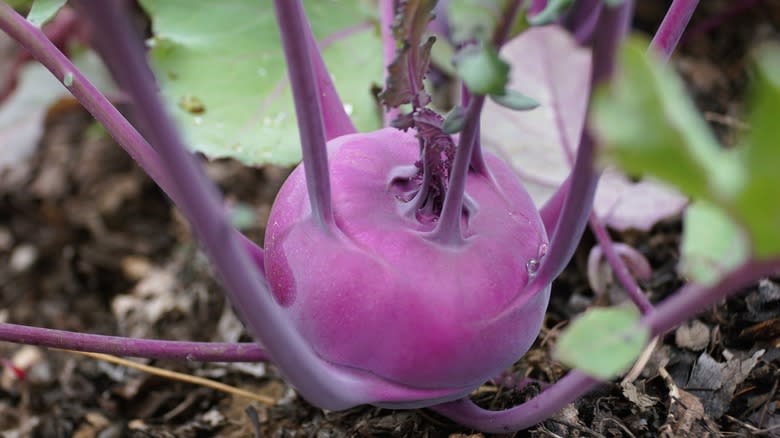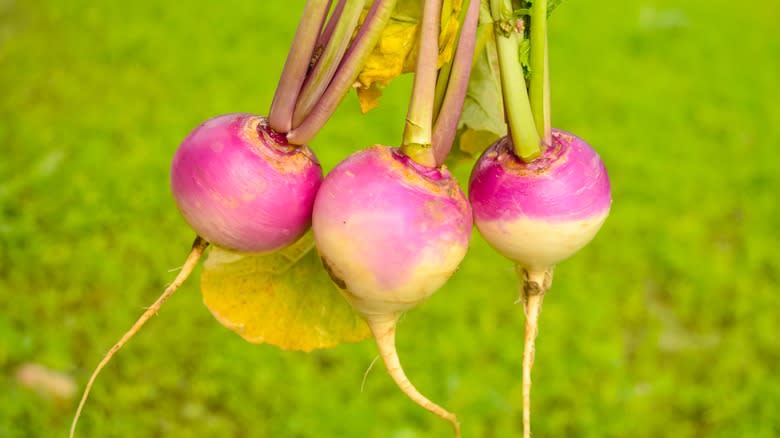Kohlrabi Vs Turnips: What's The Difference?

Where would humanity be without root vegetables? The humble potato has gotten us through hard times historically since they went global from the Americas, and carrots have been around for centuries. But there are others out there like rutabagas, beets, and radishes -- and two that probably deserve more attention are turnips and kohlrabi.
Turnips and kohlrabi do share a lot in common; their flavor, texture, and how you'd use them in cooking features a lot of overlap. Both belong to the "brassicaceae" family, but they're in different subgroups: kohlrabi is part of the same species as cauliflower, kale, red cabbage, broccoli, and Brussels sprouts, while turnips are in the same group as bok choy, rapini, and napa cabbage. This is somewhat confusing, as the name "kohlrabi" actually translates from German as "cabbage turnip," and they're often referred to as "German turnips." Despite the naming convention, though, there are plenty of differences, notably in appearance, but also somewhat in nutritional value.
Read more: 11 Of The Best Cooking Tips From Bobby Flay
The Two Don't Look Alike, But They Do Taste Similar

Both turnips and kohlrabi are small, vaguely spheroid, and (sometimes) a similar color, but you're still not going to confuse them for each other. The first reason is that while both are sometimes purplish, kohlrabi is also often light green, and turnips feature that distinctive color gradation from purple to white. The bigger reason, though, is the stems: turnips have a pretty standard-looking-for-root-vegetables stem, while kohlrabi have stems that are sometimes described as "alien-like" since they are spread out across the vegetable and there are tons of them. The only brassica with an argument for being odder-looking is romanesco.
The texture and flavor does vary between turnips and kohlrabi, even though they're not far off. Turnips are known for their hard crunch, while kohlrabi is somewhat softer. And while turnips are known for having a bitter, slightly spicy taste (though not as pronounced as something like a radish), kohlrabi is a bit sweeter and more mild. The leaves do taste somewhat different between the two, with turnip leaves having a peppery quality while kohlrabi leaves a taste sort of like kale or collard greens.
The Two Are Cooked Pretty Much The Same Way

If you're wondering how you can use kohlrabi, meanwhile, the answer is basically exactly how you'd use a turnip, as the two are often regarded as interchangeable. Both should probably be peeled (although it's not necessary strictly speaking), and from there, you can use them in a roasted root vegetable mix, or raw in salads, or even mash them; while mashed turnips are pretty well-established, kohlrabi also functions well under the same treatment. Basically, which you pick often comes down to whether you'd prefer a milder and sweeter or more bitter and spicy flavor, and whether you want more or less crunch.
Nutritionally, there's also both overlap and differences. The two are identical in calories, carbohydrates, and folate, though kohlrabi has more vitamin C (although turnips also have a fair amount), vitamin B6, and potassium, while turnips win out on calcium. These aren't huge differences, though, so you can generally consider them to have similar nutritional profiles.
Read the original article on The Daily Meal.

 Yahoo Lifestyle
Yahoo Lifestyle 
